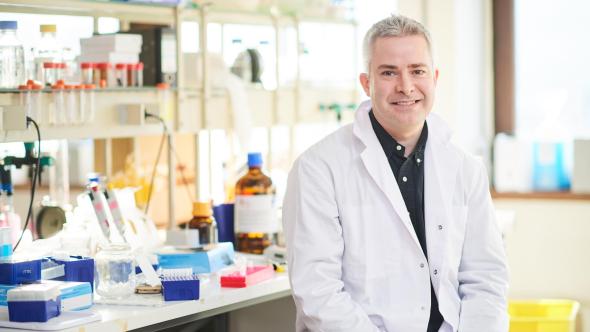The liver is our body's largest internal organ and plays an essential role in many vital functions such as digestion and detoxification. As a result, although diseased, the liver is very well equipped to resist chemical agents sent into the body to treat it, such as chemotherapy. On the strength of his expertise in the field of multi-drug resistance in cancer, Professor Jean-Pierre Gillet, Director of the Department of Biomedical Sciences and the Laboratory of Molecular Cancer Biology at UNamur, is one of the linchpins of a new research project devoted to the resistance mechanisms of hepatocellular carcinoma conducted in collaboration with Drs. Lionel D'Hondt and Quentin Gilliaux, oncologists at the Medical Oncology Department of CHU UCL Namur - site de Godinne.
Olfactory receptors under the microscope
This project focuses on olfactory receptors, proteins localized in the membrane of sensory neurons in the nasal cavity, but which are also found expressed elsewhere in the body. Beyond their role in odor detection, these receptors have highly interesting properties in terms of treatment: they are, in fact, so-called "highly druggable " therapeutic targets, i.e. particularly receptive to small molecule drugs, but also to biological drugs such as, for example, antibodies. In other words, they are excellent candidates for the development of drugs that can bind to them effectively and modulate their function to produce the desired therapeutic effect. Based on the existing literature and Professor Gillet's previous work on liver cancer, the following question arose: would olfactory receptors be specifically expressed in liver tumors and, if so, play a role in their development and mechanisms of resistance to treatment?
To answer this question, an interdisciplinary collaboration was set up between various partners. The Biobank of the CHU UCL Namur in Godinne, which preserves tissue samples taken in particular during tumor removal, made it possible to build up a representative collection of healthy livers, diseased (cirrhotic) livers and liver tumor tissue. Messenger RNA was extracted from these three types of tissue, then sequenced (a method which identifies the genes expressed in the cells). Data analysis was then carried out at Namur Molecular Tech, a molecular biology technology platform located on the Godinne university site and directed by Dr Degosserie. This work led to the identification of six olfactory receptors specifically expressed in tumor cells, and hitherto little studied. They are therefore promising candidates for further investigation of the original hypothesis: deciphering the role of these receptors in the development of treatment-resistant liver tumors.
Support from Roche Belgium
Thanks to their joint expertise and the innovative nature of their research, UNamur and CHU UCL Namur - site de Godinne have been awarded a €50,000 grant to further explore the role of these six olfactory receptors. In collaboration with the CHU Research Laboratory and in particular Dr Morgane Canonne, the UNamur Cancer Molecular Biology Laboratory is currently developing in vitro models, such as organoids, or mini-organ, from liver tumor biopsies. These models will make it possible to test the biological role of olfactory receptors within the cell: does the expression of these receptors in tumor cells induce an increase in their proliferation or aggressiveness? Do they accelerate the generation of metastases in other tissues? Or, on the contrary, does a lack of activation of these receptors contribute to these mechanisms? Depending on the answers to these questions, it will be possible to assess whether these receptors constitute good therapeutic targets within the primary liver tumor, with a view to blocking its metastatic capacity or slowing its development. The ultimate aim is to test targeted treatments on cells from these models, with a view to developing therapeutic alternatives that will offer new hope for patients.
.


